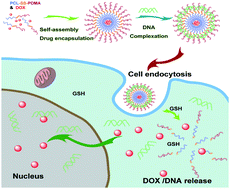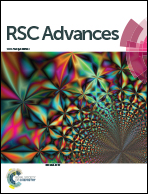Sheddable, degradable, cationic micelles enabling drug and gene delivery
Abstract
In this work, sheddable, degradable, cationic micelles were designed and developed based on intermediate disulfide-linked poly(ε-caprolactone)-b-poly(N,N-dimethylamino-2-ethylmethacrylate) (PCL-SS-PDMA) diblock copolymers, for glutathione (GSH)-mediated intracellular delivery of anticancer drug doxorubicin (DOX) and gene. The PCL-SS-PDMA diblock polymers with different PDMA block lengths were prepared by a combination of ring opening polymerization (ROP) and atom transfer radical polymerization (ATRP). Driven by hydrophobic interaction, these polymers self-assembled into nanoscaled micelles with size ranging from 70 to 200 nm, and positive surface charges from +24 to +37 mV. The PDMA length was found to determine the surface charge and in turn affect the physiochemical properties and cumulative drug release. More importantly, glutathione mediated intracellular drug release was observed by intracellular fluorescence arising from DOX for the GSH treated cells. The accelerated drug release was induced by the structural disassembly after disulfide cleavage. The PCL-SS-PDMA block polymers exhibited high DNA binding affinity and cellular uptake efficiency. The gene transfection efficiency of PCL-SS-PDMA/DNA complex showed relatively low transfection efficiency in 293 T and HeLa cells, compared to PEI 25K. However, the transfection efficacy dramatically outperformed PEI 25K in human oral carcinoma cell lines (KB and CAL-27 cells). A ten-fold population of the transfected cells was found for the PS-SS-PDMA polymer, compared with PEI. The experimental results show the great potential of the new micelles in gene and drug delivery for cancer therapy.


 Please wait while we load your content...
Please wait while we load your content...